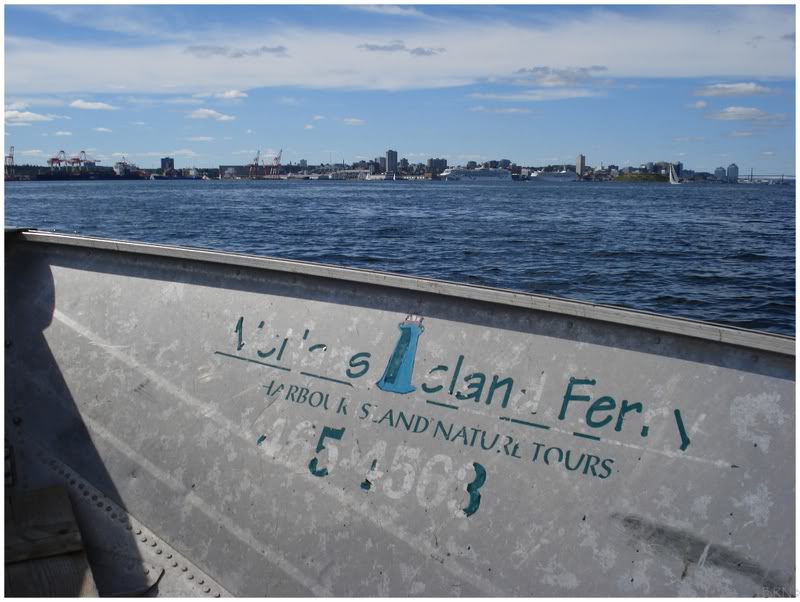
McNåbs Island
Halifåx Harbour, Nova Scotiå
Fall 2007.
Near the beginning of my Novå Scotiån days, I was perusing some éxploring website and kept coming across locations that were part of the Hålifax Defense Complex. The Hålifax Defense Complex is a series of forts and towers about the mouth of the Hålifax Harbour that protected the strategic city for over 250 years.
Nowadays, there isn't much threat to Halifax and many of the forts sit in ruin or restored for park use.
McNåbs Island is the largest island in Halifax Harbour and is home to a great selection of restored and ruined forts. My obsession with islands and the obscurity of the place led me to check it out fairly quickly after arriving in Novå Scotia.
To reach the island, you can take your own boat or you can pay a certain fisherman $11 at the local harbour. My boat was undergoing repairs at the time, so I called up the local fisherman. We organized a meetup time and place. I showed up and donned my life jacket to boat across Halifax Harbour to the island.
The island was originally used by the native peoples of the area. The first white men to take notice of the island were the French Navy who considered building a fortified seaport there (they chose the area where Louisbourg is located instead).
After the French Navy decided upon Louisbourg instead, Hålifax merchant Joshua Maugher began using the long beach for fishing activities. The island was purchased about 40 years later by Peter McNab - beginning a long McNab family settlement on the island.
Beginning in the 1860s, the British began purchasing parcels of land from the McNab family to establish forts upon the island. The island actually used to be a popular destination as 1000s of people would cross over for the fairs in the early 1900s.
The island came largely under military control during WWI and WWII because of its importance in providing access to Halifax Harbour. A submarine net was laid between McNabs and the mainland at this time to prevent German boats from entering the harbour.
The fisherman gave me a map of the island and drew me a route. One of the things that interested me the most was the 'abandoned barges' square.
Not much remains of the barges today - an old boiler in the first picture and some extremely decayed wood in the second.
Instead of following the map and route the fisherman gave me, I decided to just walk the coast.
Apparently this was the location of the old McNab's Island dump. I found some interesting Halifax bottles.
I also found some less than desirable broken Halifax bottles. As with most hand cuts, I just kept gushing blood - great, just great.
Thankfully it wasn't that deep and I just ripped a portion of my sock off and wrapped it up. The fisherman later asked what happened and just shook his head when he found out that I climbed the old dump hill.
I had organized to meet with the fisherman to get off the island 4 hours later. Unfortunately, all the coast walking and dump pile climbing left me in a hurry. It was really frustrating when I started to realize what the island had to offer - this was Fort Ives.
Fort Ives was built at the northern tip of McNab's Island in 1864. It continued full use until the time period between the World Wars. It was during this time, that Fort Ives was re-evaluated and found to be redundant. Forts were needed further seaward in the harbour and even the submarine net was moved more south on McNab's Island. The only reason Fort Ives was even partially used in WWII was because of the rapidity of which Europe's stabilization had decayed - which didn't leave enough time to construct new, more southern forts.
Fort Ives continued to serve as a barracks until 1943 - when it's involvement with the Halifax Defense Complex came to an end.
It provided a chill place to eat a couple granola bars and sock-bandage up my thumb.
I read about åbandoned homes on the island - this isn't what I had in mind.
I found the old water pump house and it held more semblance of an åbandonment than the maintained forts.
Even without finding many åbandonments, it was a great day to be out in beautiful Novå Scotiå.
This picture was shot near Hangman's Beach where the British Navy used to hang deserters and leave them hanging as a message to other sailors who pondered desertion.
The last stop of the hike was Fort McNab.
Fort McNab features a few more buildings which you can enter - even if they were just empty shells.
It appeared as if there may have been some possibilities for going more underground, but I didn't have the proper footwear.
I was absolutely rushing and I needed to hurry back in time to meet the fisherman.
It was not nearly enough time for McNabs & I always meant to go back ever since this day in September - but never did.
Navi
Back to Main.